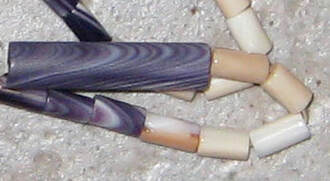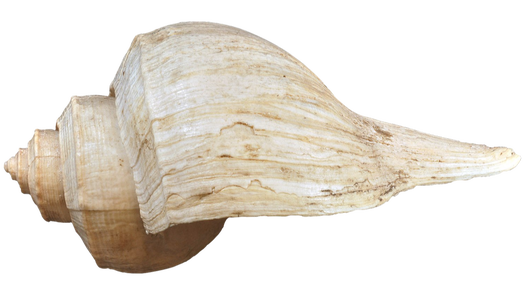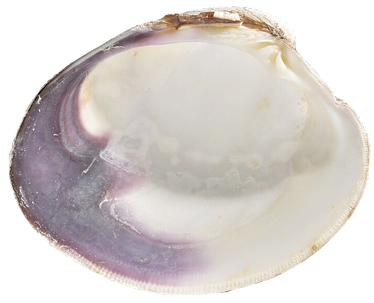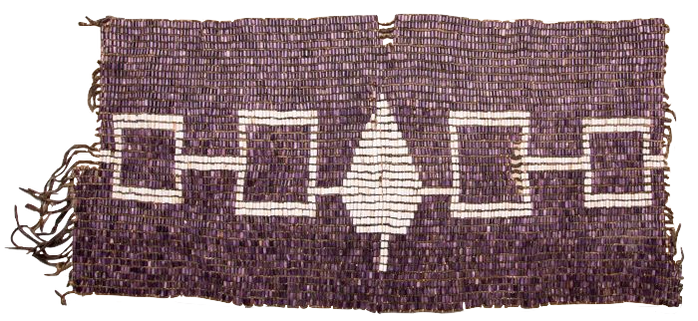Wampum beads were arranged and strung together in intricate patterns and designs that typically served as a visual memory keeper recording important messages, agreements, and historical events. These beautiful creations came to be known as wampum belts in English, though they typically were not worn in the same way we think of belts today. The use of wampum belts used to be thought of as something belonging only to the Haudenosaunee and Wampanoag people, but historians now believe it was far more widespread that previously thought. There is now evidence of a wampum tradition amongst the Ojibway, Odawa and Potawatomi people. Examples of wampum belts Arguably the most famous wampum belt is the Hiawatha belt made to tell the story of the creation of the Haudenosaunee nation (also known as the Iroquois Confederacy or just the five nations). The Seneca, Cayuga, Onondaga, Oneida, and Mohawk people warred for a very long time. When they decided to join together in peace, the Hiawatha wampum belt was created to record the event. The box on the far left stands for the Mohawk who were the first to join, then the Oneida. The central figure is a white pine, the tree of peace, where the warring nations buried their weapons. It symbolizes the Onondaga. Next is the Cayuga, and then the Seneca. Note that they are all joined together. This was a reminder to maintain the peace. The Wolf Treaty belt represents the alliance of the Seven Nations (an alliance of seven Native communities in what is now Canada) and the English. The figures in the center represent King George I and a Native person joining hands in peace. The wolves were there to protect the peace path. Note the seven dark lines by each wolf. These purple lines represented the Seven Nations. In 1890, this was written about the belt: "One wampum, now owned by Margaret Cook, the aged aunt of Running Deer, represents the treaty of George I with the Seven Nations. The king and the head chief are represented with joined hands, while on each side is a dog, watchful of danger, and the emblem is supposed to be the pledge: 'We will live together or die together. We promise this as long as water runs, skies do shine, and night brings rest.'" You can find photos and stories of more wampum belts at the Onondaga Nation website: https://www.onondaganation.org/culture/wampum/ Anishinabek Nation. “What Are Wampum Belts?” YouTube, 23 June 2021, https://www.youtube.com/watch?v=95PojatWRdc.
Bonaparte, Darren. The Wolf Belt. http://www.wampumchronicles.com/wolfbelt.html. Accessed 29 Mar. 2024 “Hiawatha Belt.” Onondaga Nation, 18 June 2014, https://www.onondaganation.org/culture/wampum/hiawatha-belt/. Historica Canada. “Richard Hill.” YouTube, 2 June 2020, https://www.youtube.com/watch?v=8Ckxi7rjGac&t=717s. Nahwegahbow Windspeaker, Barb. “Wampum Holds Power of Earliest Agreements.” Ammsa.Com, 2014, https://web.archive.org/web/20190228192256/https://ammsa.com/publications/windspeaker/wampum-holds-power-earliest-agreements#sthash.Bv7JG8PF.dpuf. “Wampum.” Onondaga Nation, 18 Feb. 2014, https://www.onondaganation.org/culture/wampum/. “Wampum Belt.” Plimoth Patuxet Museums, 30 Aug. 2023, https://plimoth.org/yath/unit-2/wampum-belt. |
Author
I often struggle to find websites with thorough explanations in simple language to help kids understand historical events or scientific concepts, so I decided to create some of my own! -Cookie Davis
Archives
March 2024
|





 RSS Feed
RSS Feed